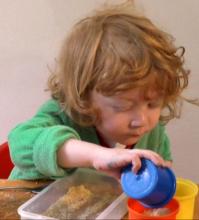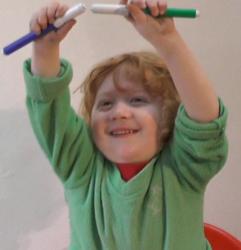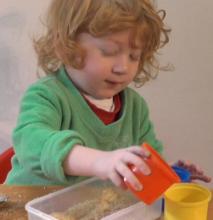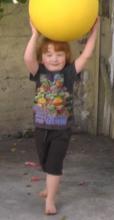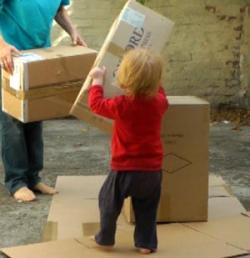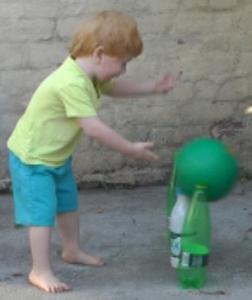What a toddler of 18-36 months should be able to do
By 18 months most toddlers have acquired the fundamental gross motor abilities at a basic level of control. Over time, and with practice, in typically developing toddlers, the skill level improves dramatically.
Toddlers with movement difficulties (developmental coordination disorder, low muscle tone, joint hypermobility, autism) may need help acquiring and improving theses skills.
Here I provide a list of all the basic motor skills, sometimes referred to as fundamental motor patterns, that toddlers should acquire between 18 months and 3 years of age.
Sitting on a chair or stool
Sitting on a stool and playing at a table
- Sits erect on a small stool or chair.
- Stays erect when using the hands in front of the body.
- Sits at a table to draw or play for 10-15 minutes.
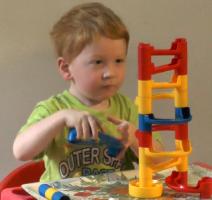
Able to reach for toys in all directions
- Reaches forwards, to the right and the left.
- Can reach across the body.
Can reach up with both arms and maintain balance
- Can lift both arms together when building towers and moving large objects.
Reaches across body
- Still moves the head, trunk and arms as a unit when reaching across the body.
- The trunk twists as the arm reaches across the body to the other side.
Sitting on the floor
Sits comfortably with legs in front of the body
Ring or cross legged sitting.
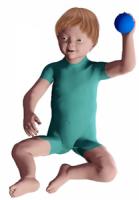
Twists and reaches forwards and to both sides
Twisting and reaching when sitting on the floor is important for developing good flexibility in the hips and trunk.
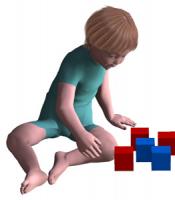
Sits up from lying by pushing up on one arm
- Sits up quickly and easily.
- Legs lift up as toddlers lifts up head and trunk.

Lies down from sitting on the floor
- Leans back and lies down, without needing to support on arm.
- Movement is controlled - and neck is flexed until the very end of the movement.
- The ability to control the head when lying back is important because it stops the toddler's head from hitting the floor when he/she looses her balance and falls backwards.
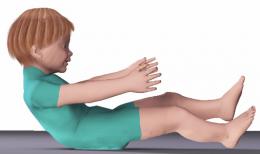
Stands up from sitting
- Movement is quick and easy, child uses momentum.
- Pushes briefly on one or both hands.
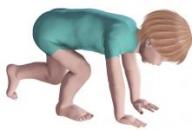
Standing balance and stability
Stands easily and independently with feet hip width apart
Can look to the side and behind. This action requires good standing balance as the legs and feet have to adapt to the twisting action of the head and trunk.

Reaches down to pick up toys from the floor
- This requires good leg muscle strength to support the body weight as the legs bend in a controlled manner.
- This action also requires good balance: the buttocks must shift backwards as the trunk tips forwards.
Can stand, hold and maneuver a large object
- Lifting and moving large and heavy objects challenges trunk stability and balance.
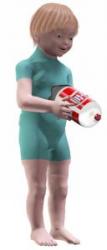
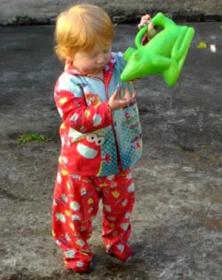
Can lift a ball and throw it from above the head
- Maintains balance, may take a small step.
- This actions requires good muscle strength (legs, arms, trunk) as well as very good balance control.
Stands on a raised surface with confidence
Low stool, bathroom step, low plank bridge.
- Standing on a high surface is important for developing tolerance of heights and balance when standing on a raised surface.
- Toddlers also need to learn to judge whether they can step down from different heights.
Walking
Walks on an even surface with confidence
- Does not fall or trip easily.
- Looks ahead, avoids obstacles, notices changes in surface, slope.
Walks across an uneven surface
Out of doors, on grass, on an uneven path.
- Looks ahead to plan steps.
- Foot placement is adapted to suit the irregular surface.
- Ankle muscles must work to stabilize the foot.
- Falls occasionally, but not regularly.
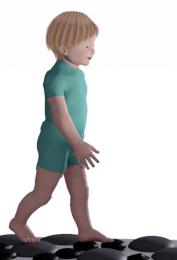
Walks on a soft surface
Can walk across a mattress, over pillows large sofa cushions laid on the floor.
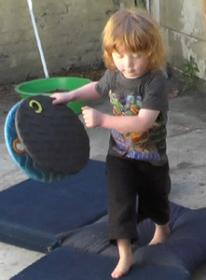
Walks up and down a 15-200 slope with confidence
- This requires good balance, especially walking downhill.
- Step size needs to be adjusted and the trunk needs to be slightly inclined to keep it balanced over the feet.

Walks on a 20-30 cm wide raised plank with confidence
Walking on a raised surface challenges the toddlers balance, because the drop-off on ether side changes the visual information the toddler uses for maintaining balance.
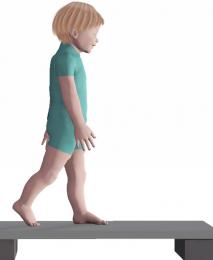
Walks carrying large or heavy objects
- Carrying large and heavy objects challenges a toddler's balance, trunk muscle strength and stability, as well arm and leg strength.
- It also requires careful use of visual information for planning actions.
Help your child Toddler Training Guide Just $20 for a 12 month subscription
Exercises and activities for for improving your toddler's strength, coordination and balance Read more
Stepping up and over
Steps over a small obstacles laid end-to-end.
Early walkers will usually first stop in front of the obstacles before stepping over.
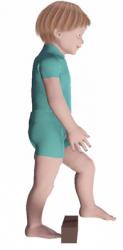
With practice and walking experience, toddlers learn to walk or run and step over any small obstacles in their without first stopping.
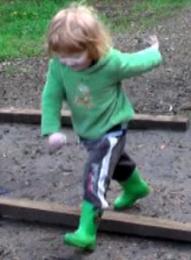
Steps up onto a 10-20 cm high step
- May initially need hand support.
- After some practice can step up without hand support.

Steps down from a 10-20 cm high step
Initially with hand support, with practice with no hand support (by 3 years of age).

Walks up stairs holding the stair rail or an adult hand
- Walks up one step at a time - ie one foot on the next step, back foot follows and is put down on the same step.
- By age 3 years a toddler who regularly walks up stairs should be able to walk up without holding onto the rail.
- It takes a little longer before a young child can go up stairs moving the bottom foot up passed the front foot onto the next step.

Walks down stairs holding the stair rail or an adult hand
Walking down is more tricky than walking up stairs.
Stepping down requires good coordination of the action of the hip, knee and ankle muscles.
In addition, the trunk needs to be slightly inclined to keep it balanced over a changing support base.
Steps over a gap between low steps
(by 3 years)
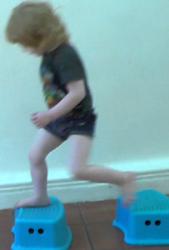
Standing up, sitting down and squatting
Can stand up from a 10-15 cm high step
- Does not push up on arms
- Can stand up and sit down several times in a row with good control.

Can squat down and stand up again
- With good control - movement is graded
- Can also hold in-between positions

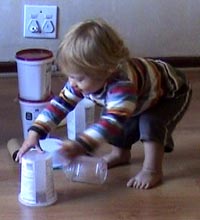
Stands up from sitting on floor easily and quickly
- Pushes briefly on the hands as he gets up.
- Can also sit down on the floor from standing with good control.
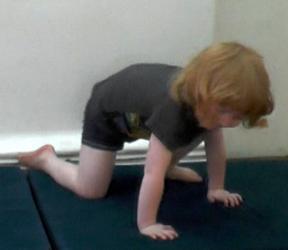
Running
Runs easily on an even surface
- Has fairly good balance on even ground.
- May get a speed wobble when stopping or changing direction suddenly.
- Can run and stop suddenly and also change direction suddenly without falling over.
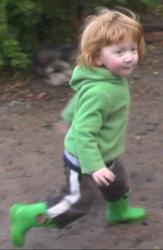
Runs on uneven ground
More likely to fall running on uneven ground and especially running downhill.
When falling the hands are used to break the fall
Does not bang head when trips and falls forwards.

Climbing and clambering
Clambers up onto a couch, bed or chair
Is able pull self up by pushing or pulling with the arms.

Climbs onto a dining room chair and turns around to sit
This requires good planning abilities and coordination between trunk and limbs.
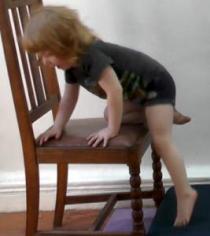
Climbs up onto a low table or dinning room chair and stands up
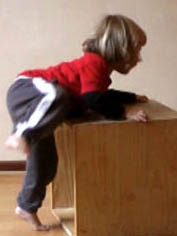
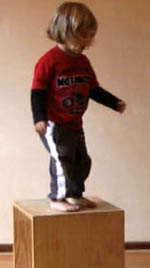
Climbs onto the lowest rungs of the jungle gym
The ability to climb on a jungle gym with confidence takes practice. A child's abilities will depend on experience.

Slides down a small slide with confidence
- Climbs the ladder of a small slide.
- Gets to the top of a slide and sits down ready to slide down.
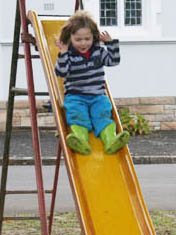
Jumping
Jumps up off two feet
By the age of 2-3 years a toddler should be able to jump up off two feet and then land on two feet again.
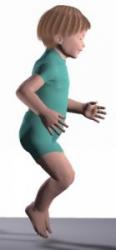
Jumping up off two feet has two stages: bending the knees to prepare for jumping, then rapidly extending the legs and taking off.
Sometime after the second birthday one sees toddlers getting ready for a jump by bending the legs and then working hard at developing the coordinated between the hip, knee and ankle muscles needed for launching the body into space.
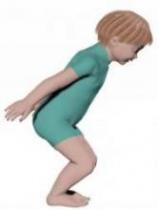
Jumps over a low obstacle with two foot take off (by 3 years)
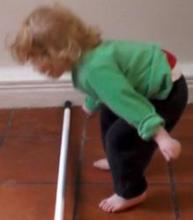
Jumps down from a 20-30 cm high step
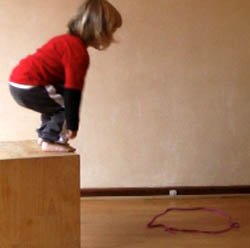
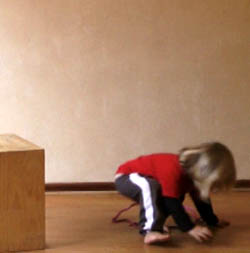
Runs and jumps/leaps over a low obstacle
One foot take-off (by 3 years)

Ball skills
Catches a soccer sized ball with two hands
- Holds arms ready to catch.
- Catches ball on forearms and then bends arms and secures ball against chest.
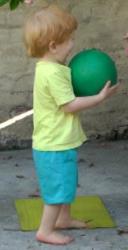
Throws a soccer sized ball with two hands
Still has poor control of direction
Kicks a soccer sized ball
Control of the direction is poor.
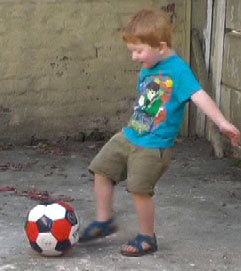
Intercepts a rolled ball
Watches the direction of the rolling ball and moves towards it to stop it with two hands.
Watches direction of rolled ball and moves to a position where the ball can be stopped using the hands.
This important skills trains visual attention, predicting the direction of the ball and moving to the right place at the right time. All these skills are needed for catching a ball.

Help your child
Toddler Training Guide Just $20 for a 12 month subscription
Exercises and activities for for improving your toddler's strength, coordination and balance Read more
For therapists
TOMT 0-3 Training Guides
Assessment, analysis, training activities
